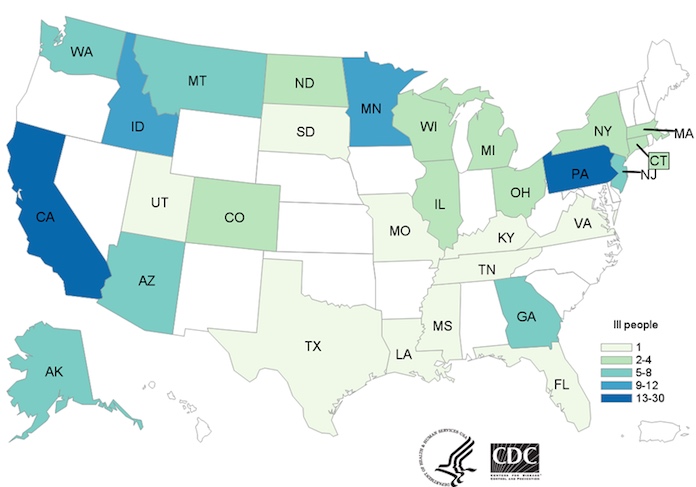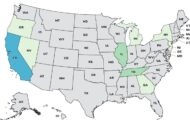The E. coli O157:H7 HUS outbreak that is linked to romaine lettuce has grown again. Now 149 people are sick in 29 states. Of the 129 of those 149 who have been interviewed, 64, or 50%, have been hospitalized because they are so sick. Seventeen people have developed hemolytic uremic syndrome, or HUS, a type of kidney failure that is a complication of this type of infection. One death was reported in California. Lawsuits have been filed in this outbreak.

Since the last update on May 2, 2018, 28 more ill persons have been added to the outbreak total. Four more states have been added too: Minnesota, Florida, North Dakota, and Texas.
The case count by state is: Alaska (8), Arizona (8), California (30), Colorado (2), Connecticut (2), Florida (1), Georgia (5), Idaho (11), Illinois (2), Kentucky (1), Louisiana (1), Massachusetts (3), Michigan (4), Minnesota (10), Mississippi (1), Missouri (1), Montana (8), New Jersey (8), New York (4), North Dakota (2), Ohio (3), Pennsylvania (20), South Dakota (12), Tennessee (1), Texas (1), Utah (1), Virginia (1), Washington (7), and Wisconsin (2). The patient age range is from 1 to 88 years.
The most recent illness began on April 25, 2018. Any illnesses that occurred in the last two or three weeks may not have been reported to officials yet, because there is a time lag between when someone starts feeling sick and they go to a doctor, are diagnosed, then reported to public health.
The CDC is still saying that consumers should not buy or eat romaine lettuce unless you can absolutely confirm it is not from the Yuma, Arizona growing region. The problem with that is that produce is rarely marked with the region where it was grown. This lettuce has a shelf life of up to 3 weeks, and some could still be in restaurants or homes. This advice includes hearts of romaine, whole heats, chopped romaine, baby romaine, organic romaine lettuce, and any salads or salad mixes that contain this leafy green.

You can contact food safety attorney Fred Pritzker for help by calling 1-888-377-8900 or 612-338-0202.
Investigators are still interviewing patients about where they ate and the foods they ate before they got sick. Ninety-one percent said they ate romaine lettuce, which is significantly higher than results from a survey, in which only 46% said they ate romaine the week before they were interviewed.
Meanwhile, be aware of the symptoms of an E. coli infection and HUS. With E. coli, people usually have painful abdominal cramps and bloody diarrhea. With HUS, there is little urine output, pallor, lethargy, and easy bruising. Both of these conditions can be life-threatening, so call your doctor immediately if anyone you know has these symptoms.
Pritzker Hageman law firm, located in Minneapolis, Minnesota, helps people sickened by food contaminated with E. coli O157:H7 and other pathogenic bacteria get answers, compensation and justice. We vigorously protect our client’s legal rights. Our lawyers represent their clients and families of children in personal injury and wrongful death lawsuits against grocery stores, food producers, shippers, dairies, restaurants, retailers, and schools. In 2016, attorney Fred Pritzker and his team of experienced lawyers won $7.5 million for young client whose kidneys failed after he developed hemolytic uremic syndrome because of an E. coli infection.




